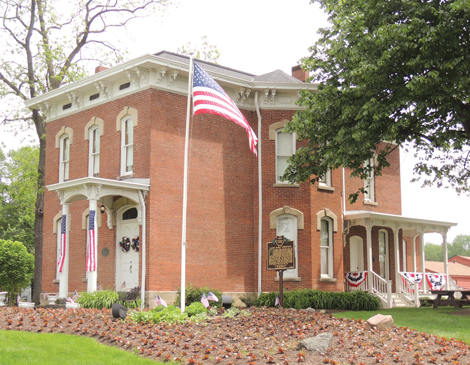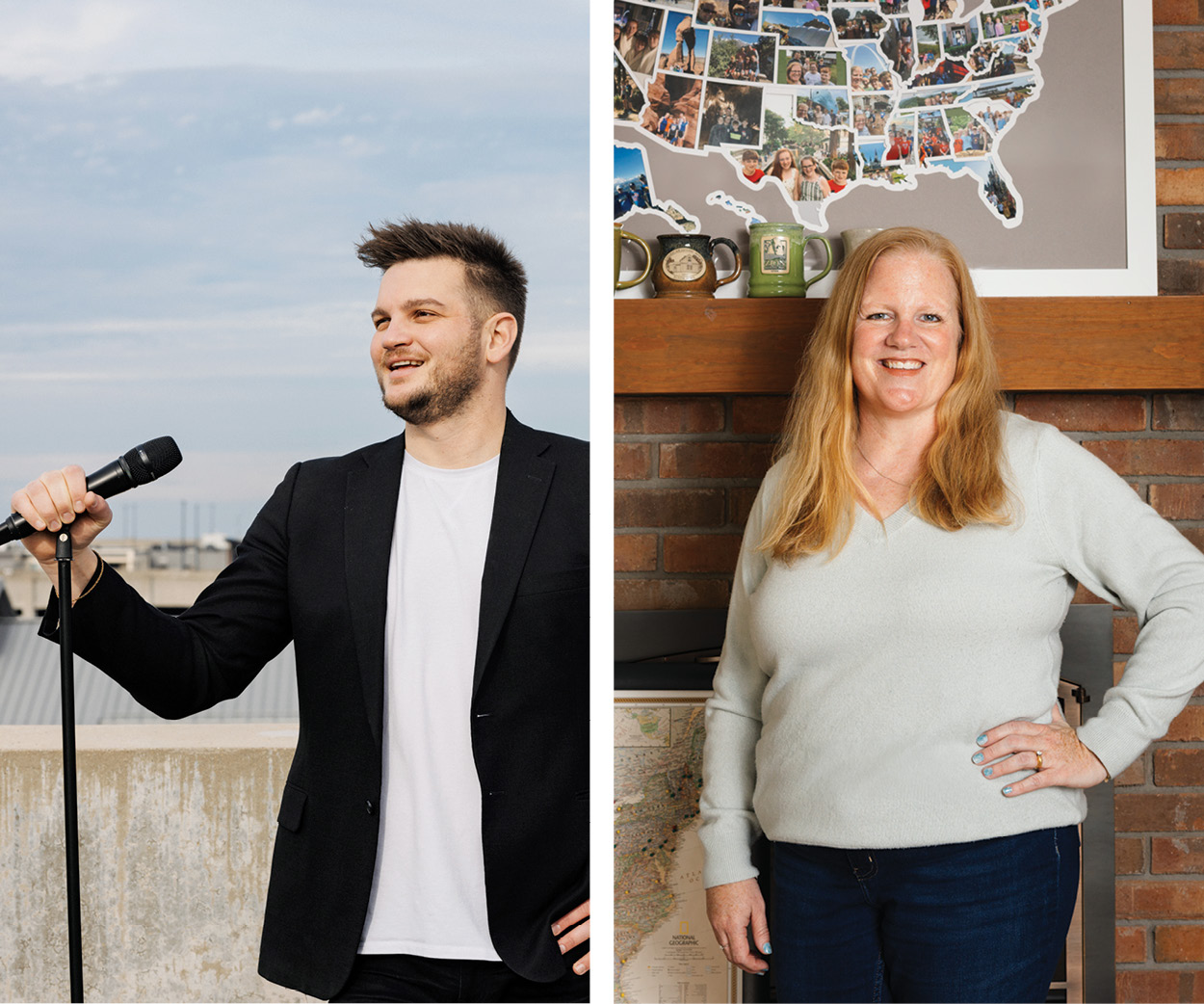Surrounded by 21st-century office complexes and neighborhoods, it’s easy to see why drivers might overlook the simple sandstone home at 27946 Center Ridge Road as they keep a sharp eye out for destinations that include the Westlake Recreation Center next door.
But thanks to a grant Westlake received from the Ohio Facilities Construction Commission, along with funding from the city, state and residents totaling more than $400,000, the 179-year-old Lilly Weston House is getting the attention it deserves. Plans call for the dwelling to become a museum and historic site filled with artifacts honoring its past along with the city’s beginnings.
A native of Blue Ash, Ohio, Lysa Stanton, who’s presided over the Westlake Historical Society since 2010, married Dave Pfister, who hails from Olmsted Falls, in August 2003. Three months later, the couple moved to Westlake. It didn’t take long for them to fall in love with the history the city embraces.
The Lilly Weston House
“We have wonderful places like the Lilly Weston House throughout our country that matter,” Stanton reflects. “We can’t save them all, but we need to do what we can. One of our goals at the Historical Society is to get people interested about what they’re seeing. We say, ‘You may not like history, but you must admit you’re curious.’ They might drive by an historic home every single day of their life. We need to let them know there are volunteers behind those doors who want to share the history.
“Sometimes people forget,” she adds, “that these buildings have a story to tell.”
Like many of the early residents of Dover Township — renamed Westlake Village in 1940 — Austin Lilly (1788-1848) and his wife Roxanna Sears Lilly (1793-1868) moved here in 1832 from Massachusetts. The couple built the sandstone house in 1844, and family members lived there until 1867. The original home is made up of a basement and first floor. A second floor was constructed in 2022.
“At one time, the property consisted of 160 acres,” Stanton says. “Records indicate that the Lillys were farmers who grew fruits and vegetables which they transported to what is now downtown Cleveland to sell.”
The sandstone used to meticulously construct the house by early Ohio builders is thought to have come from a quarry which is now part of the current Bradley Woods. The blocks are 2 feet thick, and more finely tooled and dressed in front of the house than on the sides and rear. Thick, hewn timbers support the massive roof.
“I’m overwhelmed and amazed, not with the size of the house because it’s relatively small, but with the size of the sandstone and what it must have taken to get it there,” Stanton says.
A brick wing was added to the home’s east side in 1850, and the house had several owners through the decades, including George Weston, James Beardsley and August Trudel.
The groundwork for the city’s Lilly Weston House historic preservation plan was laid in 2000, when Weston’s great-granddaughter Alice Ladanyi and her family deeded it to the city for $1 on one condition: The dwelling was to be used exclusively as a museum and historic site.
The National Park Service placed it on the National Register of Historical Places in 2001. Two years later, after an extensive review process, the Ohio History Connection — a nonprofit organization chartered in 1885 and dedicated to preserving and sharing our state’s history — added the historical marker that’s visible from the street. Initiated in the 1950s, the Ohio Historical Markers program encompasses 1,750 markers placed on properties across the state based on their significance. Approximately 20 new markers are accepted into the program each year.
Stanton credits Mayor Dennis Clough and his team for understanding and appreciating the home’s crucial role as a portal to the past.
“The mayor has been phenomenal,” she says. “He loves history and has always gone to bat for us and has been with us on every step of this journey. Mayors in other cities may not be as involved with the history of their communities as ours is. We’re blessed to have him.”
After funding was secured, the city hired contractor R.W. Clark to complete the foundation work, add new flooring, repair water damage, shore up masonry and replace rotted joists.
“The company specializes in working on historical structures,” says Pfister, a member of the Westlake Historical Society Board. “I’m amazed that instead of installing all-new windows, they were able to repair much of the original glass.”
The firm also replicated the design of the original woodwork, and made the house ADA-accessible.
“We envision this gem to become a treasure trove that demonstrates and displays early Dover history,” says Stanton, who adds that plans call for the museum to open in late spring-early summer. “We’re looking forward to having schoolchildren — as well as the community-at-large — visit, and creating interactive activities for them.”
Items the Historical Society has acquired that will be placed in the home include a Weston family bed and dresser, an uncovered wagon, a one-horse open sleigh, a child’s sleigh and farming implements.

The Clague House Museum
The Lilly Weston House is the ideal complement to the city’s second historic home, the stately 147-year-old Clague House Museum, located at 1371 Clague Road. It was placed on the National Register of Historic Places in 1975 and awarded an Ohio Historical Marker in 2013.
Robert Clague (1802-1875), the family patriarch, immigrated to Dover from the Isle of Man in 1829 before returning there a few years later to marry Margaret Cowell (1810-1884). The couple came back to Dover with their first child in 1837 and set up housekeeping in a log cabin on the property. In 1876, a year after Robert’s death, seven of their nine children built the Italianate beauty now standing on the property for their mother, who lived there until her death.
“Robert and Margaret had a reputation for being very frugal,” Stanton says. “When their children presented their mom with the house, they also gave her $1,000 to purchase furniture. She thought the amount, as well as the house, was too extravagant.”
But, Stanton adds, Margaret was often lauded for her generosity and known for loaning money to neighbors and writing off debts.
The Clague family farm eventually blossomed to include a total of 78 acres of vineyards and orchards on the west side of what is now Clague Road. Robert Clague also had a hand in clearing more than a mile of trees to help construct what is now Clague Road.
Through the decades, the Historical Society conducted meticulous research on each of the siblings’ lives: Ruth (1837-1902) was a school teacher in Cleveland; Victoria (1839-1930) married Ezra Tuttle in 1873 and enjoyed writing poetry; John (1841-1864) enlisted in the Union Army during the Civil War and died in Philadelphia of an illness he contracted during the Battle of the Wilderness; Thomas (1843-1924) also enlisted in the Union Army and served during the Civil War before returning to work on the family farm; Walter (1846-1934) built Clague Pond; Sophronia (1848-1934) taught at McKinley School in Lakewood, enjoyed painting and was known to be an excellent manager of money; William (1850-1902) enjoyed working on the farm; Edward (1853-1866) died of typhoid fever when he was 13; and Charles (1856-1927) graduated from Oberlin College, studied law and went into real estate. He married Florence Hall in 1886 and was the only family member to live outside of Ohio.
In 1929, Sophronia Clague and her brother Walter deeded the house to the city on the conditions that they could live there until they died, that the home would include a library and that the remaining 78 acres surrounding it would forever become Clague Memorial Park. Following their deaths in 1934, the homestead was modernized and used for various purposes until the mid-1960s, when the Historical Society began efforts to restore it.
Visitors to what is now The Clague House Museum will step into nine rooms that serve as time capsules of days gone by.
“This is truly a living-history home,” Stanton says, as she points to Clague family pieces that include an organ, secretary and whatnot shelf in the parlor, and Victorian-period pieces in the bedroom.
Upstairs, a military museum honors veterans with displays of uniforms from a variety of conflicts. The Sophronia Clague Memorial Library chronicles her family’s history and contains archives documenting Westlake’s growth. As a service to their community, members of the Historical Society are on hand to help residents trace their own family’s history.
Experience a Piece of History
“We’re not your grandmother’s historical society,” Stanton says. “We do a lot of dusting, but that’s not all we do. We have a great team of incredible volunteers who do all the history stuff — and make it fun at the same time.”
That’s especially true when it comes to those ready to say, “I Do.” Each year, more than a dozen or so couples choose to have their wedding ceremony in the opulent parlor, and Historical Society members are only too happy to make it a day to remember. The free nuptial package for up to 24 guests includes the officiant, recorded music, flowers and bride-and-groom cupcakes.
“Because Dave and I are professional photographers, we throw in the photos, too,” Stanton says. “If you want an intimate wedding, we’ve got you covered. It’s a best-kept secret we want to share.”
The Historical Society also hosts free Vintage Baby, Off-To-Kindergarten and Pet photo shoots where families can bring their infants, children and four-legged pals to pose in themed settings and period clothing.
On June 4, the society’s 51st annual Craft, Vintage & Antique Show on The Clague House Museum grounds will feature dealers from across Northeast Ohio proffering precious finds for sale.
“We’re really excited about being able to showcase both of these significant chapters in Westlake history,” Stanton says, “and introduce visitors to that rare, little stone house on Center Ridge that’s truly withstood the test of time.”




